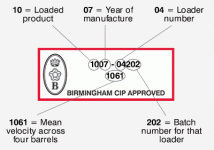H
hiknmik
Guest
Good evening all,
First time here and scratching my head some.
I have shot for many years but it was always "shoot what ya got" in my lower grade guns. I now have a better bolt action rifle for a starter/training gun, a CZ455 varmint.
I have gotten the brenchrest bug and need an education. I understand some ammo shoots better in certain guns while other ammo does not.
Everyone keeps mentioning "a good shooting lot" but what makes or defines or indicates a good shooting lot? I don't mean"it shoots better" I mean what do you first look for? What could the differences be that makes a good lot?
All things equal like, gun with a good barrel, good technique etc.
We'll use Eley Match as our test ammo. Eley lists lot and FPS for each run.
1) I see FPS from about 1048 to 1078, does FPS come high on the list of what to look for? Would other lots with similar FPS shoot the same in a the same barrel?
2) Does rim thickness play a major role?
3) does overall bullet length play a major role?
4) You get the idea.
I would assume Eley does not assign a certain casing run to a certain bullet run or do they? Some people talk about watching for a certain machine run or operator?
Lots of questions I know but BR seems to be a thinking man's game. if you have somewhere on the internet to direct me for more information that would be helpful also.
Thank you in advance for taking the time to read and/or respond.
Safe shooting and score a ten.
Thanks Mike
First time here and scratching my head some.
I have shot for many years but it was always "shoot what ya got" in my lower grade guns. I now have a better bolt action rifle for a starter/training gun, a CZ455 varmint.
I have gotten the brenchrest bug and need an education. I understand some ammo shoots better in certain guns while other ammo does not.
Everyone keeps mentioning "a good shooting lot" but what makes or defines or indicates a good shooting lot? I don't mean"it shoots better" I mean what do you first look for? What could the differences be that makes a good lot?
All things equal like, gun with a good barrel, good technique etc.
We'll use Eley Match as our test ammo. Eley lists lot and FPS for each run.
1) I see FPS from about 1048 to 1078, does FPS come high on the list of what to look for? Would other lots with similar FPS shoot the same in a the same barrel?
2) Does rim thickness play a major role?
3) does overall bullet length play a major role?
4) You get the idea.
I would assume Eley does not assign a certain casing run to a certain bullet run or do they? Some people talk about watching for a certain machine run or operator?
Lots of questions I know but BR seems to be a thinking man's game. if you have somewhere on the internet to direct me for more information that would be helpful also.
Thank you in advance for taking the time to read and/or respond.
Safe shooting and score a ten.
Thanks Mike


